Whether you’re an experienced hiker or you’re needing tips for hiking for beginners, you’ll want to bring the right gear along for your trip. Knowing what to bring hiking is crucial to ensuring you’re prepared while not overburdening yourself with extra hiking gear that can add weight and slow you down.
Fortunately, it doesn’t have to be complicated–we’ve put together a hiking checklist that covers all of the day hiking essentials and long-term backpacking necessities you should bring on your outings.
Browse through the items we’ve outlined below to put together the perfect day hiking packing list for your next day hike or multi-day adventure!
Contents
Backpack
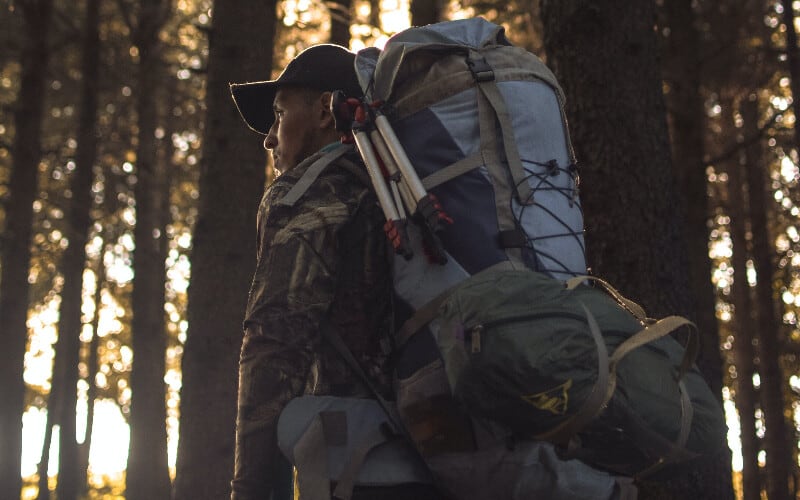
Before we get into the gear you need to bring along on your hiking trip, let’s take a quick look at a hiking essential you’ll need to keep your gear organized: a hiking backpack.
A backpack is absolutely necessary when going long distances. A backpack designed specifically for hiking allows you to carry all of the gear you need in an organized way, keep it safe from the elements, and allows for quick retrieval of the equipment you need.
Additionally, a good backpack has adjustable straps that allows you to tighten and secure your day pack for proper weight distribution-which can make your hike much more comfortable and reduce the odds that you experience pain and discomfort.
Related: The Best Backpack & Daypack Options
Pack Cover
Protecting your backpack and gear from the elements is important, as rain can quickly soak through your gear and leave you miserable. Even if you’re going on a short day hike, a pack cover may come in handy if you get hit with a surprise rain shower when you’re out on the trail.
Clothing
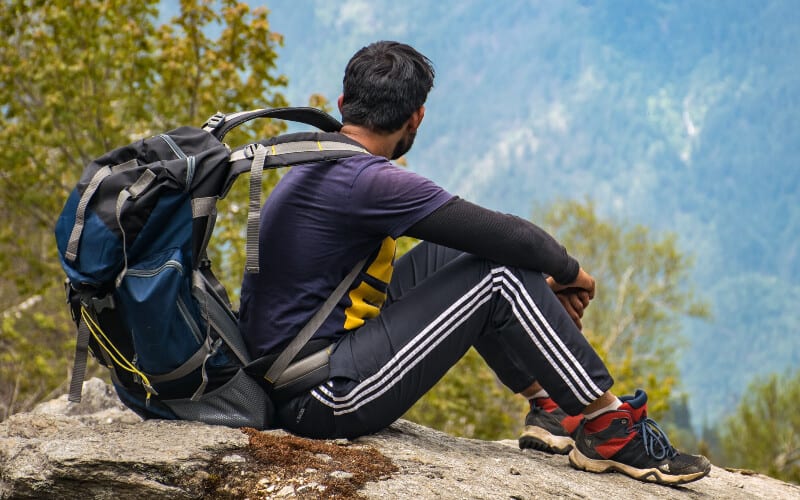
Whether you’re going on a short hike or planning an extended backpacking trip, the hiking clothes you choose to wear can make or break your outdoor adventure.
Avoid Cotton Clothing
While there are many fabrics to choose from, you should avoid cotton clothing if at all possible. Clothes made from cotton are rough and scratchy, and can cause rashes and irritation.
Cotton may seem like a great choice as it’s fairly breathable, but it can be problematic because it’s not good at wicking away sweat–which means it absorbs sweat and can weigh you down on your day hike.

While cotton is a very breathable fabric, it absorbs sweat and gets heavy. Not only can that be uncomfortable, but it can cause issues during colder trips. In fact, sweat-soaked cotton clothing can lead to loss of body heat, which can cause hypothermia–which can be life-threatening.
Instead, opt for clothing made of synthetic materials, as outlined below.
Use a Layering System
Wearing or packing multiple layers of hiking clothes is highly recommended. Even if you don’t wear all three layers (base, mid, and outer layers) at the outset, it’s a good idea to take all layers on every outing: You can peel off layers if things heat up, but you can’t put on layers that you didn’t bring along.
Base Layer
The base layer, also referred to as the underwear layer, is the layer of clothing that you wear closest to your skin. A good base layer should effectively wick sweat off your skin to help maintain an ideal body temperature.
Choosing the right clothing for this layer will depend on the temperature and weather you’re expecting.
For warmer weather, an ultralight base layer may be ideal. A lightweight base layer is great for mild temperatures and general year-round outdoor activity. Midweight clothing is great for fall as the weather starts to cool down. During the winter, a heavyweight base layer may be ideal (especially if you’re in regions with more extreme cold temperatures).
Merino Wool as a Base Layer
Merino wool has become a popular fabric for this layer of clothing. It’s softer and thinner than regular wool and is great for regulating your body temperature. It traps air and insulates you in cooler temperatures, and wicks away sweat on warmer days–keeping you dry and cool.
Shirts & Tops
Wearing a comfortable, weather-appropriate shirt will make your time on the trail much more comfortable and enjoyable. If you’re going to be in hot weather, a tank top or light shirt may be all you need. If you’re in cooler weather, a lightweight shirt designed to keep you warmer (insulated or wool-based) may be a better choice.
Click here for more information about how to choose the best shirt or top for your next day hike.
Underwear
The right underwear is another hiking essential that you don’t want to overlook. While it’s easy to not give your underwear much thought, you may regret your lack of planning half way through your trip.
When choosing underwear, it’s important to choose a pair (or pairs if you’re planning a multi-day hike) that is designed to wick away sweat. You’ll also want a pair that fits correctly–underwear that is too loose can bunch up and cause discomfort, while underwear that’s too tight can cause chafing, pain, and irritation.
Women looking for support during their hike should consider a well-fitting sports bra that is made of a fabric designed to wick away sweat.
Underwear comes in a variety of styles for men and women, and each have their pros and cons. For more information about various underwear options, take a look at our Choosing the Perfect Underwear guide.
Hiking Socks
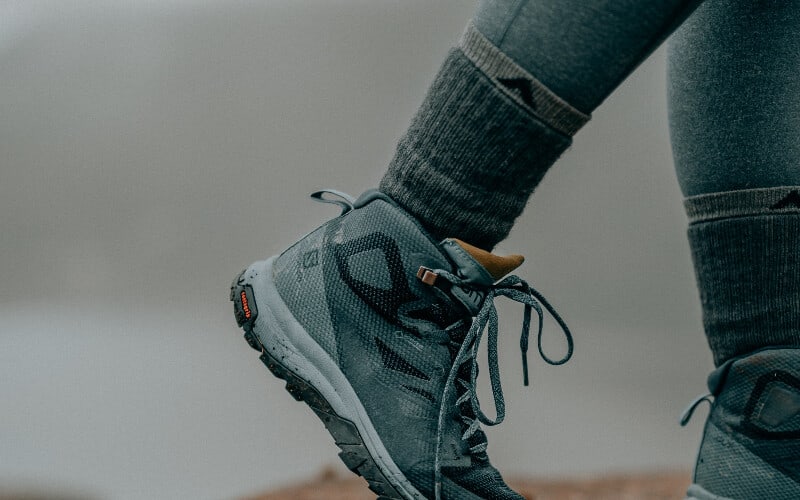
Socks are a very important part of your base layer. Wearing the wrong socks can lead to sweaty, cold, clammy feet-which can be a real downer during your outing. Poorly fitting socks can also contribute to blisters along the back of your heels.
For nice weather, a lightweight to midweight brand of sock can keep your feet at the perfect temperature without causing excessive sweating. For colder weather, you can wear a pair of thin socks as a liner, and a pair of thicker, heavyweight socks (such as wool socks) to keep your feet warm during your day hike.
However, it’s important to keep in mind that wool socks can be very effective at retaining heat–sometimes a little too effective if you aren’t in very cold temperatures. Choosing a sock fabric such as merino wool can offer the best of both worlds: socks that keep your feet warm when its cold, and dry and cool in warmer weather.
Related: The Best Hiking Socks
Mid Layer
The mid layer, also referred to as the insulating layer, is the layer you wear over your base layer to help retain heat and regulate your body temperature.
Mid layer clothing is worn over your shirt to help keep you warm while without causing you to overheat. In warm or moderate weather, a mid layer may not be necessary. For mildly cool weather a mid layer may be all you need, but a mid layer can also be worn under a warmer jacket in cold and/or inclement weather.
In warm weather, a pair of hiking shorts over your underwear may be all you need for legwear. If you’re planning on hiking in cooler weather or hiking through areas with thick greenery, a pair of hiking pants will likely be a better option.
If the weather forecast is showing cool mornings and hot afternoons, or hot afternoons and cool evenings (depending on what time you’re going to be out), you can look into wearing convertible pants. Convertible pants are exactly what they sound like: hiking pants that can be detached to turn into shorts as needed.
Outer Layer
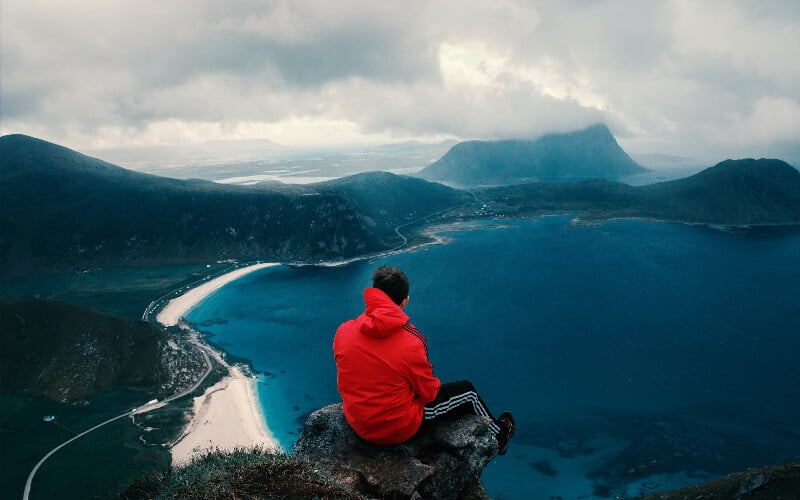
The outer layer, or shell layer, helps retain body heat to keep you warm, and can help protect you from the elements.
If you’re planning on moderate weather, an outer layer may not be necessary. However, if you’re expecting cold temperatures or inclement weather (rain or wind), an outer layer can be a life saver.
Rain gear can be worn over your other layers (for both your shirt and pants) to help keep your clothes dry and add another layer of warmth when needed. A good rain jacket can help keep you dry no matter how bad a storm may get, and you’ll be glad you brought one if you find yourself in a downpour out on the trail. Many jackets are designed to be lightweight but effective, and they can fit nicely in your pack without taking up much space.
Hiking Footwear
When you’re going on a hike, it’s important to make sure that you have the right shoes. Some shoes are not made for hiking, so you want to make sure that you’re not tearing yourself up and losing blood or tissue in your feet.
When it comes to footwear, you have three primary categories to choose from: trail running shoes (trail runners), hiking shoes, and hiking boots.
Trail Runners
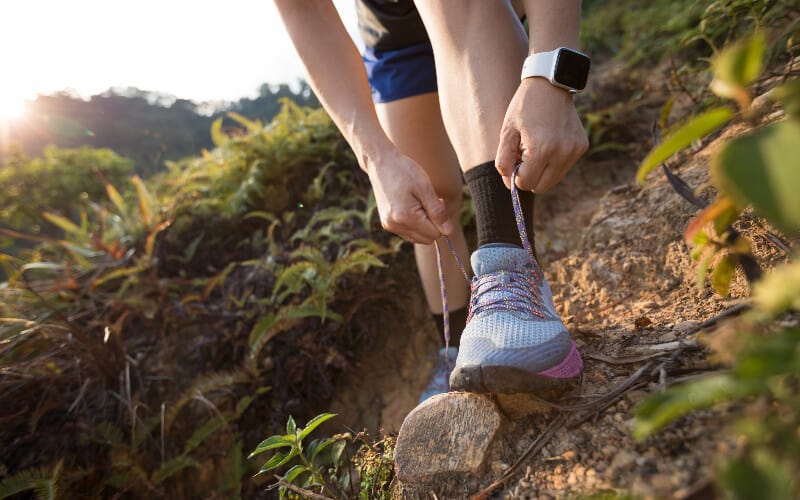
Trail running shoes are the lightest category of footwear. They’re great for running across rough terrain, but they’re not as durable as other options.
If you’re planning on running, trail runners are your best bet–heavier-duty shoes will slow you down and can cause pain.
See our review of the best trail running shoes for men, women, and children.
Hiking Shoes

Hiking shoes are best if you plan on hitting a hiking trail that doesn’t consist of rough terrain and doesn’t change drastically in elevation. Shoes are thicker than runners but not as heavy-duty as boots, but they tend to be fairly light and will help keep your feet comfortable and protected during a day hike.
Related: The Best Hiking Shoes
Hiking Boots

Hiking boots are the best option if you’re going to be travelling across rough terrain. If you know your path is going to be littered with rocks or if it contains steep inclines or slopes a pair of heavy-duty boots may be your best bet.
Related: The Best Hiking Boots
Accessories
The clothing outlined above and appropriate footwear are all you really need to be prepared for your trip when it comes to clothing. However, there are a few other accessories you can bring along to make your outing even more comfortable and enjoyable.
Sunglasses
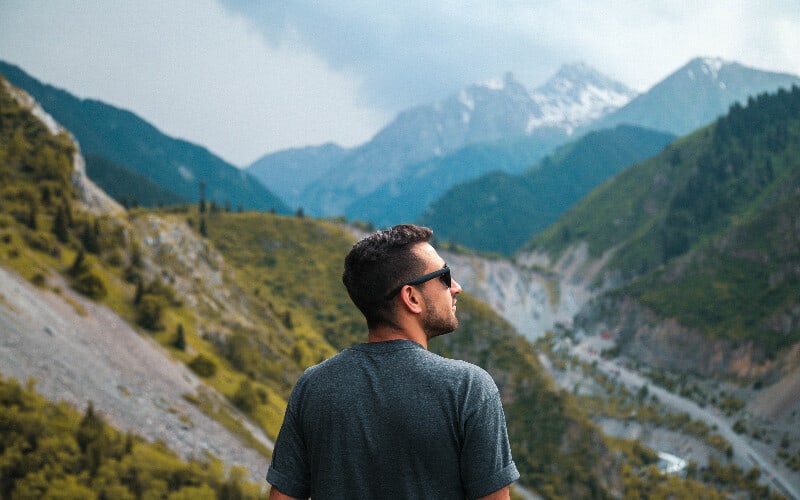
If you’re expecting clear skies during your trip, a good pair of sunglasses can make your hiking experience so much more pleasant.
Not only will you be able to enjoy your adventure without squinting, but you’ll also be protecting your eyes from harmful UV rays. As an added bonus, sunglasses can also help shield your eyes from dust and keep them from being dried out and irritated by wind.
Related: The Best Sunglasses
Hats

Hats can serve multiple purposes on your trips. If you’re going out on a bright, sunny day, a hat can help shield your eyes and protect your face from harmful UV rays. On colder trips, you can opt for a hat that keeps your ears and the top of your head warm.
Gloves
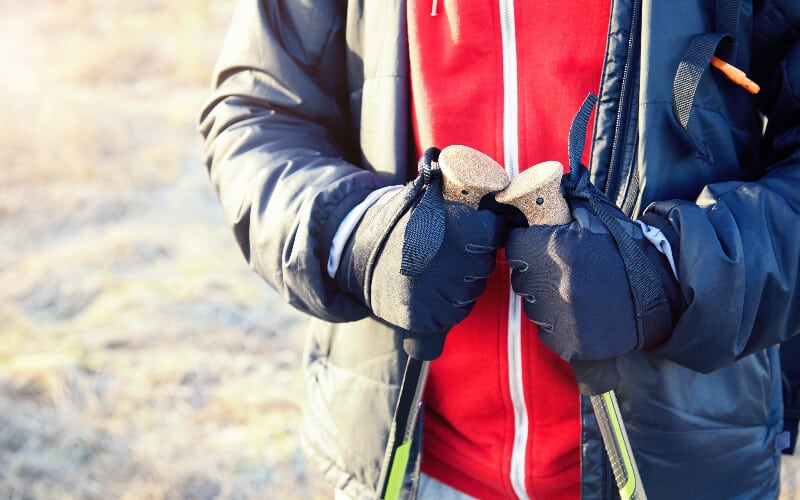
Similar to hats, gloves can serve multiple purposes on trips. On colder days, a pair of gloves can keep your hands warm and protect them from wind and the elements. If you’re going to be using a hiking pole (discussed below), gloves can help prevent blisters, callouses, and irritation.
Scarves
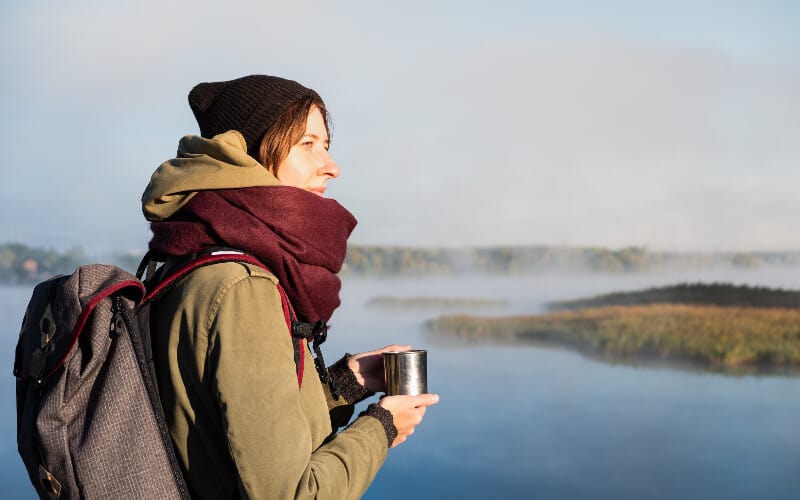
Scarves technically fall in the “outer layer” section, but they may not be a necessary piece of hiking gear unless you’re planning on hitting a trail in very cold environments. However, many scarves are lightweight and don’t take up much space, so it may be handy to bring one along to help protect you from wind, cold, and the sun.
Sun Protection
Whether you’re planning a short hike or a long backpacking trip, you’re going to find yourself exposed to the sun. While the sun is great for keeping you warm, it can be harmful with prolonged exposure (even on overcast days!).
Sun protection should be high on you list of day hike essentials, as it can keep you safe from harmful UV rays.
Sunscreen
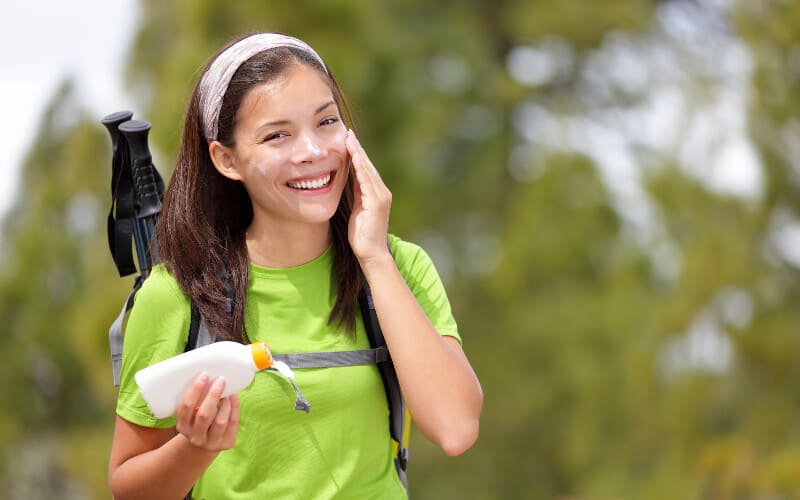
It’s important to apply sunscreen to your face and any exposed skin periodically during your hike. According to dermatologists, you should reapply sunscreen every two hours-even if the sky is cloudy. If you’re wearing clothing that covers a lot of your body (long-sleeved clothing, long pants, and/or a hat), it’s still important to frequently apply sunscreen to your exposed skin (face, hands, etc.).
SPF Lip Balm
Most people don’t think about protecting their lips from the sun when they’re applying sunscreen to their face and body. While it’s easy to forget to shield your lips from the sun, it’s very important to do so–especially when you’re going going to be in the sun on a multi-hour day hike.
Skin cancer is very common around the lip area, so applying and reapplying some UV-rated lip balm every few hours can help keep you safe from the sun’s harmful rays. Plus, lip balm can help keep your lips from drying out and chapping during prolonged exposure to wind and the elements.
Knowing where you’re going is always important-and doubly so when you’re out in unfamiliar terrain. With the way modern technology has advanced, the gadget you always keep on you-your smartphone-can be a great navigation tool.
However, most smartphones have a very limited battery life, so it’s important you don’t rely solely on it during your adventure. Instead, utilizing a combination of modern and ancient navigation technology is the most reliable way to ensure you don’t get lost.
Also, bringing along your smartphone may prevent you from fully immersing yourself in nature during your day hike, so many people choose to leave their phones behind… this can make for a great experience, but it’s important you bring along some navigation tools in your hiking gear to ensure you don’t get lost.
GPS Devices
GPS (Global Positioning System) is a fascinating technology. A network of satellites orbiting the Earth are constantly sending out signals that devices can use to precisely triangulate the device’s position-which makes it easy to figure out where you are at any given time. GPS is available all over the planet (even in the most remote of areas), is accessible 24/7, and requires no subscription.
GPS devices come in a range of makes and models, but you can get one for as low as $60 (or even less if you buy a used one). If you’re planning on spending a lot of time outdoors they’re well worth the investment.
Related: The Best GPS Devices
Maps
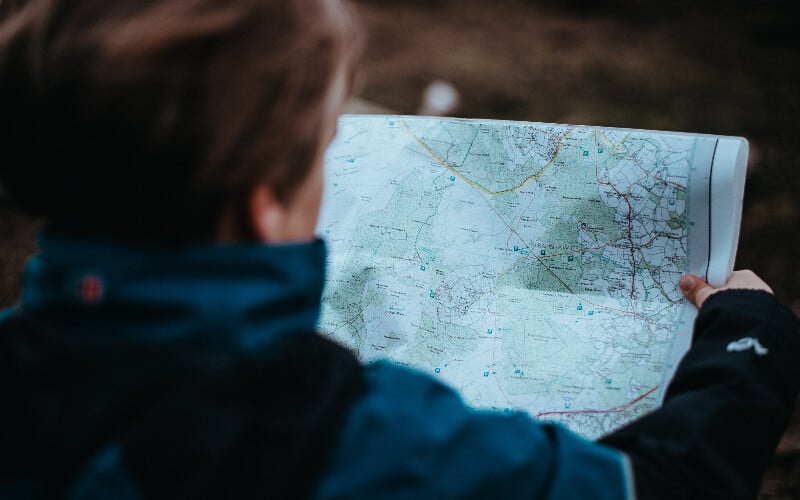
Even if you bring along a GPS device, it’s a wise idea to bring along a detailed map of the area as a backup. Ideally, you should purchase a physical map that is both waterproof and tear proof-the last thing you want is a destroyed or waterlogged map that’s impossible to read when you’re not quite sure where you are.
Compasses
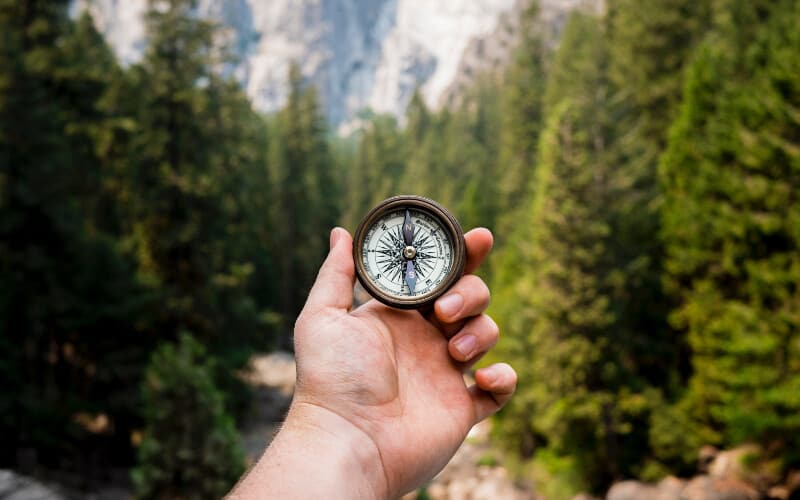
A reliable compass can help you keep your bearings in case you get turned around. Compasses are an ancient technology, but they’ve become more durable, lightweight, and compact over the years-making them a perfect companion for any hiking trip. When paired with a detailed map, you should be able to find your way in the event you veer off course or get turned around.
Related: The Best Compasses
This wouldn’t be a complete hiking for beginners guide without mentioning backup navigation. Even if you’re fully prepared with navigation technology, you never know when you might find yourself in an emergency situation. Because the unexpected can happen when you’re out in nature, it’s important that you have a way to get in touch with rescue agencies and family.
Before you head out on any hiking trip-whether alone or with a group, no matter whether the trip is supposed to be 4 hours or 4 days-it’s crucial that you let friends or family know where you’ll be, when, and to let them know when you should be back. If you don’t return when you’re supposed to, they can reach out to local authorities to quickly organize a search and rescue mission-it could save your life, and time is of the essence.
In times of emergency, relying on your smartphone is not the safest bet when you’re stuck on a hiking trail. Instead, many people choose to utilize either a personal locator beacon or a satellite messenger to get help quickly.
Personal Locator Beacons
A personal locator beacon (PLB) is an alternative to a satellite messenger, and they have some distinct advantages and weaknesses compared to messengers. These devices communicate with satellites to send SOS signals to local rescue agencies. The personnel at these agencies can track your location and get to you quickly.
Some benefits of PLBs are: they’re cheaper than satellite messengers, they don’t require subscriptions fees, they send stronger signals and work better in remote areas across the world, and their batteries can last for years.
The main downsides of PLBs are: you can’t communicate with family, and you can’t cancel an SOS call in case of a false alarm.
Satellite Messenger
Satellite messengers are more sophisticated than PLBs, but they’re also more expensive. They have a few benefits over personal locator beacons, and a few disadvantages as well.
Some benefits of satellite messengers are: they can send SOS signals to local rescue agencies (similar to PLBs), they allow for communication to others (sending and/or receiving messages), they work worldwide (though it’s important to check coverage before heading out), and some allow you to cancel SOS calls if necessary. Some GPS devices have satellite messaging capabilities, so you may be able to use the same equipment for both navigation and SOS help.
Some downsides of satellite messengers are: the devices are more expensive than SMs, they require a monthly subscription fee, their coverage varies by provider, and their batteries need recharging more often.
Hydration
Hydration is crucial when you’re on a hike. Physical activity and exposure to the elements can lead to dehydration, which can lead to muscle cramps and fatigue. Proper hydration can help alleviate the symptoms associated with dehydration.
The amount of water you’ll need to bring along depends on how long your trip will be. It’s always better to be safe than sorry, but it’s also important to avoid overpacking water so you aren’t overburdened by the extra weight water can add.
In general, you should plan on drinking about 2 cups of water per hour, or about 1 liter of water every two hours during your hike. Naturally, you’ll need more water if you’re going on a long hike. Once you know how much water to bring along, you’ll need to decide how to transport and carry your water on your outing.
Water Bottles
A good water bottle is an essential piece of gear to keep in your pack. Choosing the right water bottle comes down to preference: if you want to keep your water cold, an insulated bottle is the way to go. However, insulated water bottles are heavier and bulkier than standard bottles, so if you’re looking to minimize weight and maximize space, standard water bottles may be a better option.
Related: The Best Water Bottles on the Market
Hydration Packs
in addition to a water bottle, you may wish to bring along a hydration pack. These packs can strap on to your back or your pack and have a hose that you can sip from as you need to rehydrate. A benefit of these over bottles is they allow for hands-free operation.
Related: The Best Hydration Packs
Water Filtration System
In addition to bringing along water bottles and/or a hydration pack, keeping a water filtration system in your bag can be a life saver in emergencies where you find yourself low on potable water.
Check out our reviews of the best water filtration systems here.
Nutrition
Planning your snacks and meals and bringing the right foods along on your hike is important for several reasons. The longer your trip, the more food you’ll need–so it’s important to pack energizing foods that fill you up and give you the fuel you need to make it through your trek without taking up too much space.
Extra food will take up more space in your pack, but it’s a good idea to bring a little more food than not enough… especially if you’re going on a multiday trip.
Some classic go-to options for trail food include snacks such as trail mix and energy bars. Both energy bars and trail mix take up relatively little space, so if you’re worried about bringing too much extra food, these options can help ensure you have the fuel you need without weighing you down.
Nutrition is a whole topic within itself, so be sure to check out our Hiker’s Guide to Nutrition for lots of food ideas for your next outing.
First Aid Kit
When it comes to hiking for beginners, safety should always be a top-ranked priority. A well-stocked first aid kit is another essential item every hiker should have. You never know when an injury or illness will rear its ugly head when you’re out in the middle of nowhere, so it’s important to have, at the very least, some key first aid hike essentials.
While a fully-stocked first aid kit may take up too much of your already-limited space, you can fit a lot of medical essentials into a small kit that should have you covered for most scenarios.
You’ll want to make sure you have some ointment for cuts and scrapes, bandages and adhesives, over-the-counter medications (for headaches, allergies, and coughs), and an emergency blanket.
Another important item to keep with you when you’re day hiking is bug spray-while not technically a traditional first aid item, keeping bugs such as ticks and mosquitos at bay during your adventure can help prevent possible illnesses and irritation.
For more information on the items you should keep in your first aid pack, check out our first aid kit guide.
Illumination
Unless you’re planning a short hike early in the day, packing along some lighting can be a very smart idea. If you’re planning a longer hike or multi-day backpacking trip, proper light sources are essential.
If you’re not very familiar with the trails you’re trekking through, there’s always a chance you may get disoriented or lost temporarily while you’re out exploring–having a flashlight or headlamp can be a lifesaver if you find yourself out on the trails in the dark.
Flashlights
A flashlight is high on the list of multi-day hike essentials that you should have in your pack. You never know exactly what may happen during your outing, and the last thing you want is to find yourself stranded as the sun sets with no source of light.
Related: The Best Flashlights
Headlamps
While everyone should have a flashlight in their pack, it’s a good idea to bring along a headlamp as well. A headlamp has one key advantage over a flashlight: the fact that it can be operated hands-free. If, for example, you need to build a fire or administer first aid to yourself or someone in your party, a flashlight requires a hand and can be cumbersome to use–whereas a headlamp offers hands-free operation.
Check out our headlamp reviews here!
Fire Starters
A fire starter takes up very little space in your daypack, but can be immensely valuable on multiday backpacking trips, or in emergency if your day trip runs longer than anticipated.
A good fire starter kit can help you quickly ignite a fire, which can provide you with light and warmth all night–you just need to know how to build a fire before you head out on your trip.
Related: The Best Fire Starters on the Market
Repair Kit
A first aid kit helps you repair wounds you may experience while you’re out exploring, but a repair kit helps you keep your gear functional in case you have any inconveniences.
The items you should keep in your repair kit bag will vary based on your needs, but there are some essentials that every person should have on any outing.
Some Key Essentials Include:
- A Sewing Kit
- Duct Tape
- Extra Batteries
- Utility Cord
- Scissors
For a full list of what to include, be sure to check our Backpacking Repair Kit Guide.
Shelter
If you’re planning on an overnight trip (or multiple days and nights), you’ll want to bring along a sleeping bag and a lightweight tent or hammock.
If you’re planning a short hike, a sleeping bag and tent may be overkill. Instead, a lightweight emergency shelter alternative (such as an emergency blanket–which you should have in your first aid kit–or a bivouac shelter, aka bivy or bivvy bag) might be sufficient.
Related:
The Best Backpacking Tents
The Best Backpacking Sleeping Bags
The Best Bivy Bags
Bathroom Equipment
Whether you’re out on a multi-day longer hike or day hiking for a few hours, you never know when nature may call. Keeping a few toiletries in your day pack can add a layer of comfort to your trip.
Toilet Paper
Even if you’re on an outing that’s only supposed to last a few hours, packing a roll of toilet paper in your gear is a very wise idea. In this case, it’s better to be prepared and have some TP on you and not need it than be in a situation where you need some and don’t have any.
Hiking Trowel
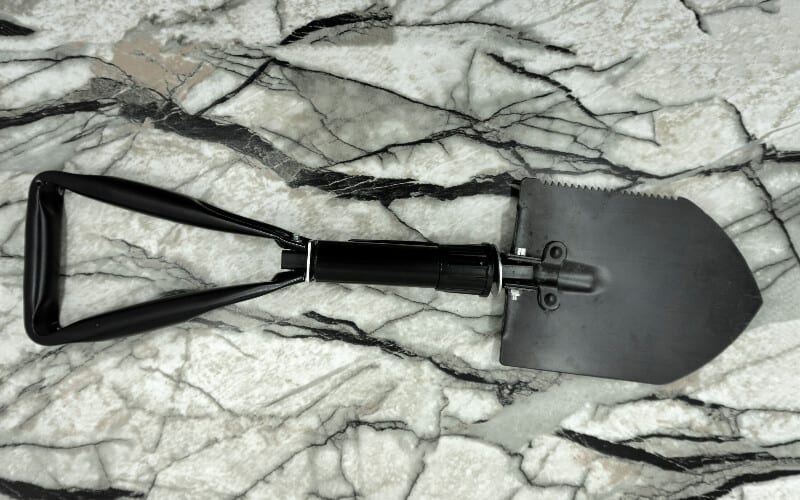
While many may not realize it, a trowel is one of the day hiking essentials that can really improve your hiking experience while making it easy to protect the ecosystem you’re exploring.
The sad fact is, the more popular a trail becomes, the more likely it is to be littered with human excrement. It’s important to play your part and do your best to leave no trace when you’re out on the trail.
There are organisms that will break down fecal matter about 6 inches down in the soil, and a trowel allows you to quickly dig a small hole (even in tougher terrain) that you can do your business in and quickly cover when you’re finished.
Extras
Whether you’re going on a quick trip or a long hike, there are a few extras you may want to consider bringing along to enhance your experience.
Camera
If you’re trying to unplug from the world and fully immerse yourself in nature on your outing, leaving your phone at home may be a top priority for you. Or, at the very least, keeping your phone off except for in case of emergency.
If your goal is to escape, packing a camera in your daypack may be a great idea in the likely event you want to capture the beauty of nature without getting bogged down by unwanted phone calls, emails, and social media alerts during your journey.
Trekking Poles
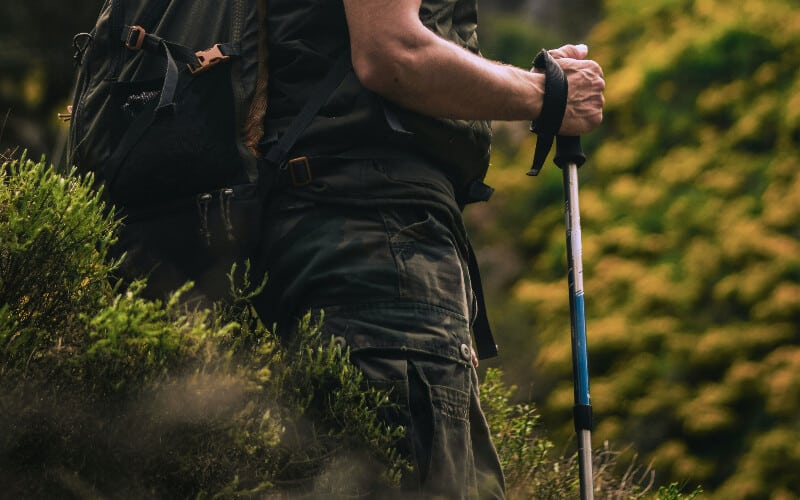
Trekking poles can be a lifesaver while you’re out on the trail. They can help you break a fall, stabilize yourself on rocky terrain, or make the hike easier if you’re on a path that has large elevation gain.
Even if you’ve packed light, a trip can be difficult when you’re hauling a pack full of gear a long distance. Trekking poles can help lighten your load and give you more stability.
In addition, a good hiking pole can help stabilize your joints and prevent or reduce pain during your trip. This is especially true if you’re going on a trek where there’s significant elevation gain.
Hiking for Beginners: Conclusion
Use everything above as a handy day hiking packing list and you’ll be well-prepared for your next day hike or multi-day adventure. Knowing what to bring hiking is half the battle, so take some time to prepare and ensure you have the essentials before your next trip.
Take time to research the trails you’ll be exploring and check the forecast so you can prepare appropriately (if it’s going to be hot, plan on wearing clothes that keep you cool; if it’s supposed to rain, bring rain gear such as a rain jacket, etc.).
Download our handy hiking checklist to ensure you don’t forget anything, and enjoy your next adventure!
https://campfiresociety.com/hiking/hiking-for-beginners-what-to-bring-hiking/



0 Comments